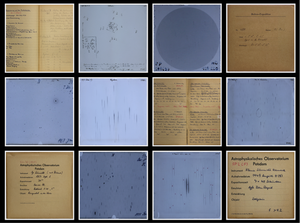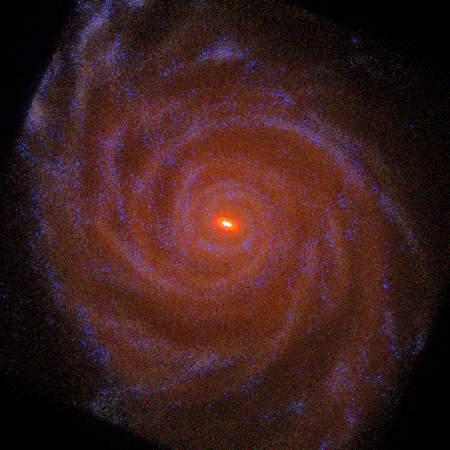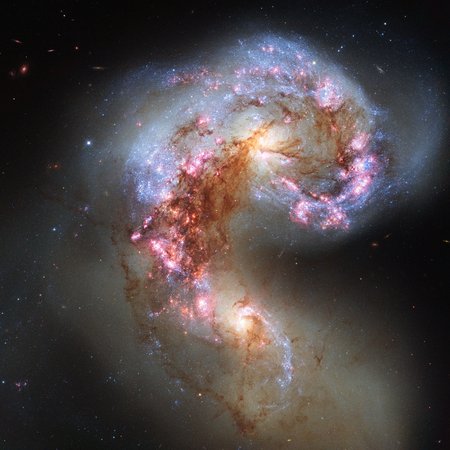Historical star data digitally available

Exposure of Andromeda nebula, taken on September 30, 1913. At this time, it was still unknown that Andromeda is a galaxy outside the Milky Way.
Credit: Hamburger Sternwarte/APPLAUSEThe large-scale digitization project APPLAUSE provides historical photographic plates from more than one hundred years of astronomical observation of numerous observatories online. The digital archive, equipped with special functions by the Leibniz Institute for Astrophysics Potsdam (AIP), not only preserves the historical inventory, but also offers the observation data of that time in a form that can be used for today's research. For example, time gaps in studies of long-term variable stars can be filled.
For more than 100 years astronomy has used photography to explore planets, stars, galaxies and other astronomical objects. At the end of the 1980s, digital receivers almost completely replaced the classic photographic plates. Thanks to their lifetime of more than 100 years, the latter are above all very reliable storage.
Hundreds of thousands of such astronomical images were lying dormant in the archives of German observatories, waiting for their second, now digital, scientific evaluation with modern computer software.
The Leibniz Institute for Astrophysics in Potsdam (AIP) alone has about 20,000 photographic plates of observations in the period from 1893 to 1970. Only through digitization can these treasures be fully analyzed. The abundance of information contained in the old photographic images allows us to take a look into the past decades and, with the aid of modern computer programs, we can measure billions of stars much more accurately and objectively. The availability of data over a period of more than 130 years allows science to take a more complete look at long-term phenomena.
Together with the Hamburg University, the Friedrich Alexander University (FAU) Erlangen-Nuremberg and the University of Tartu (Estonia), the digitization of these photo plates was tackled.

Various scans of historical photographic plates, logbooks and observation notes from the APPLAUSE archive.
Credit: AIP/APPLAUSEIn its third data release, the web archive now contains over 70,000 scans of photographic plates from the holdings of four observatories in Germany and Estonia. In addition to stars, the objects observed include planets, comets and asteroids. In total, information on three and a half billion objects was extracted from the plates and identified in comparison with modern astronomical catalogs. To do this, the scientists first assigned the sky plates to the scanned plates – with the help of PyPlate, a specially developed software. This compares the positions of the objects on the scans of each photographic plate with known constellations and calibrates the magnitudes of the objects which are affected by the plate emulsion. This step achieves comparability of the data with other catalogs. In addition, the team also manually transcribed and digitally recorded the observation notes and logbooks. Thanks to this information, the historical data can be used for scientific studies, e.g. for environmental parameters such as air temperature and observation quality, which are included in the data evaluation. At the same time, the scans of the observation logbooks also illustrate the astronomical mode of operation of the past century and are thus also of interest to historians.
The joint project of the Leibniz Institute for Astrophysics Potsdam, the Hamburg University, the Dr Remeis Observatory Bamberg, and the Tartu Observatory is funded by the German Research Foundation (DFG).

Exposure of Andromeda nebula, taken on September 30, 1913. At this time, it was still unknown that Andromeda is a galaxy outside the Milky Way.
Credit: Hamburger Sternwarte/APPLAUSEThe large-scale digitization project APPLAUSE provides historical photographic plates from more than one hundred years of astronomical observation of numerous observatories online. The digital archive, equipped with special functions by the Leibniz Institute for Astrophysics Potsdam (AIP), not only preserves the historical inventory, but also offers the observation data of that time in a form that can be used for today's research. For example, time gaps in studies of long-term variable stars can be filled.
For more than 100 years astronomy has used photography to explore planets, stars, galaxies and other astronomical objects. At the end of the 1980s, digital receivers almost completely replaced the classic photographic plates. Thanks to their lifetime of more than 100 years, the latter are above all very reliable storage.
Hundreds of thousands of such astronomical images were lying dormant in the archives of German observatories, waiting for their second, now digital, scientific evaluation with modern computer software.
The Leibniz Institute for Astrophysics in Potsdam (AIP) alone has about 20,000 photographic plates of observations in the period from 1893 to 1970. Only through digitization can these treasures be fully analyzed. The abundance of information contained in the old photographic images allows us to take a look into the past decades and, with the aid of modern computer programs, we can measure billions of stars much more accurately and objectively. The availability of data over a period of more than 130 years allows science to take a more complete look at long-term phenomena.
Together with the Hamburg University, the Friedrich Alexander University (FAU) Erlangen-Nuremberg and the University of Tartu (Estonia), the digitization of these photo plates was tackled.

Various scans of historical photographic plates, logbooks and observation notes from the APPLAUSE archive.
Credit: AIP/APPLAUSEIn its third data release, the web archive now contains over 70,000 scans of photographic plates from the holdings of four observatories in Germany and Estonia. In addition to stars, the objects observed include planets, comets and asteroids. In total, information on three and a half billion objects was extracted from the plates and identified in comparison with modern astronomical catalogs. To do this, the scientists first assigned the sky plates to the scanned plates – with the help of PyPlate, a specially developed software. This compares the positions of the objects on the scans of each photographic plate with known constellations and calibrates the magnitudes of the objects which are affected by the plate emulsion. This step achieves comparability of the data with other catalogs. In addition, the team also manually transcribed and digitally recorded the observation notes and logbooks. Thanks to this information, the historical data can be used for scientific studies, e.g. for environmental parameters such as air temperature and observation quality, which are included in the data evaluation. At the same time, the scans of the observation logbooks also illustrate the astronomical mode of operation of the past century and are thus also of interest to historians.
The joint project of the Leibniz Institute for Astrophysics Potsdam, the Hamburg University, the Dr Remeis Observatory Bamberg, and the Tartu Observatory is funded by the German Research Foundation (DFG).
Images
Exposure of Andromeda nebula, taken on September 30, 1913. At this time, it was still unknown that Andromeda is a galaxy outside the Milky Way.
Various scans of historical photographic plates, logbooks and observation notes from the APPLAUSE archive.




